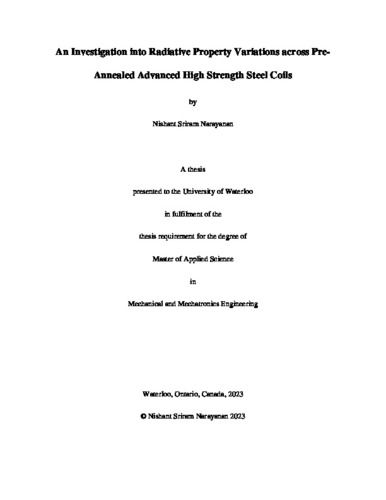| dc.contributor.author | Narayanan, Nishant Sriram | |
| dc.date.accessioned | 2023-05-29 15:44:37 (GMT) | |
| dc.date.available | 2023-05-29 15:44:37 (GMT) | |
| dc.date.issued | 2023-05-29 | |
| dc.date.submitted | 2023-05-24 | |
| dc.identifier.uri | http://hdl.handle.net/10012/19501 | |
| dc.description.abstract | In recent years, increasingly stringent crashworthiness and emissions regulations have driven automakers to consider novel materials for automotive lightweighting. Advanced high-strength steels (AHSS) used in automotive chassis construction has increased considerably. The most widely used grades of AHSS are dual-phase (DP) ferrite-martensite (α + α') grades.
Advanced high strength steel coils must be annealed with a precise heating schedule to achieve the required mechanical properties. However, temperature excursions during intercritical annealing cause erratic changes in the steel's microstructure, resulting in variations in post-annealed mechanical properties across coils. These variations lead to high scrap rates and cost manufacturers millions of dollars annually. Past research has attributed these temperature excursions to non-uniform thermal irradiation. The present work shows variations in radiative properties across a single AHSS coil may cause temperature excursions through pyrometer errors and nonuniform heating. Radiative property variations across a coil may also arise before annealing due to non-homogeneities in surface topography, influencing how the radiative properties subsequently evolve during annealing.
This thesis documents experimental and theoretical work characterising radiative property variations across a single AHSS coil processed on an industrial cold-rolling line. The ex-situ radiative properties of samples extracted from various coil locations are analysed using a Fourier Transform Infra-Red (FTIR) spectrometer equipped with an integrating sphere, revealing large swings in radiative properties along its length and width. The effect of these variations on pyrometric temperature measurements, strip temperature evolution, and in turn, the as-formed mechanical properties are discussed.
Radiative property variations are strongly correlated to differences in surface topography (particularly surface cavities) through optical profilometry, optical microscopy, and scanning electron microscopy (SEM). The work uses 3D depth mapping of optical imagery to generate surface height maps and theoretically models the radiative properties using a geometric optics approximation (GOA) ray-tracing algorithm. The GOA approach provides accurate spectral emissivity predictions within its validity regime.
The study then explores reasons for surface cavity formation, hypothesising that cavities form due to the dissolution of selective grain boundary oxides (formed during hot rolling) during acid pickling, which leads to micro-topographical changes to the strip surface. Furthermore, non-homogeneous cold-rolling parameters subsequently lead to non-uniform cavity flattening. The thesis then explores the combined effect of acid pickling time and cold-rolling reduction percentage by studying different AHSS alloys, cold-rolled and acid-pickled to different extents, through a factorial design-of-experiments procedure.
An artificial neural network (ANN) regression model for near-instantaneous spectral emissivity predictions of AHSS was developed using surface roughness parameters and optical imagery as inputs. Manufacturers can implement this model with emerging in-situ strip imaging technologies to provide real-time spectral emissivity predictions before a coil section enters an annealing furnace. Galvanisers can also use these on-line spectral emissivity predictions to update pyrometry and furnace temperature control algorithms in real time.
This thesis expands our knowledge base on the possible causes for temperature excursions across an AHSS coil during annealing. Findings of this research will benefit steel manufacturers in identifying and reducing non-homogeneities in mechanical properties across AHSS coils, reducing high scrap rates in the industry. | en |
| dc.language.iso | en | en |
| dc.publisher | University of Waterloo | en |
| dc.subject | radiative properties | en |
| dc.subject | heat transfer | en |
| dc.subject | advanced high strength steels | en |
| dc.subject | pyrometry | en |
| dc.title | An Investigation into Radiative Property Variations across Pre-Annealed Advanced High Strength Steel Coils | en |
| dc.type | Master Thesis | en |
| dc.pending | false | |
| uws-etd.degree.department | Mechanical and Mechatronics Engineering | en |
| uws-etd.degree.discipline | Mechanical Engineering | en |
| uws-etd.degree.grantor | University of Waterloo | en |
| uws-etd.degree | Master of Applied Science | en |
| uws-etd.embargo.terms | 0 | en |
| uws.contributor.advisor | Daun, Kyle | |
| uws.contributor.advisor | Daun, Kyle | |
| uws.contributor.affiliation1 | Faculty of Engineering | en |
| uws.published.city | Waterloo | en |
| uws.published.country | Canada | en |
| uws.published.province | Ontario | en |
| uws.typeOfResource | Text | en |
| uws.peerReviewStatus | Unreviewed | en |
| uws.scholarLevel | Graduate | en |

